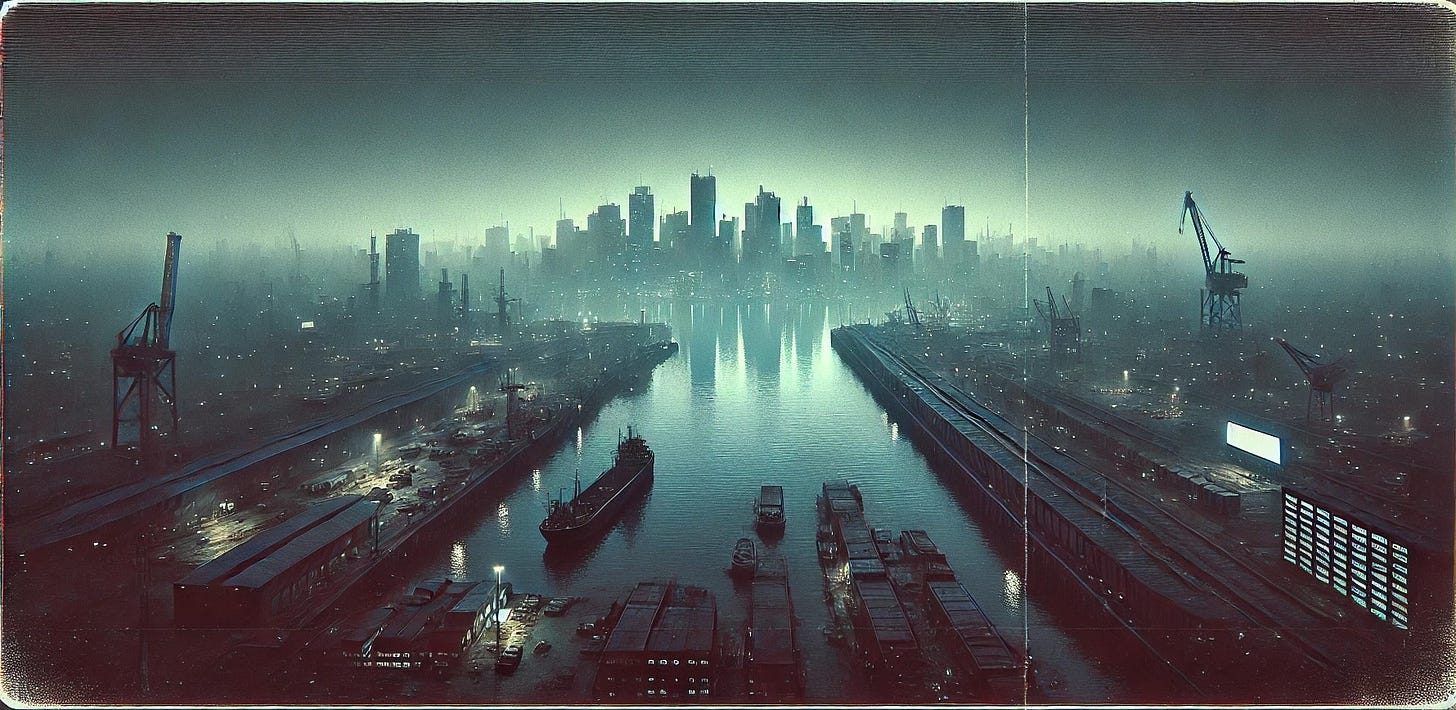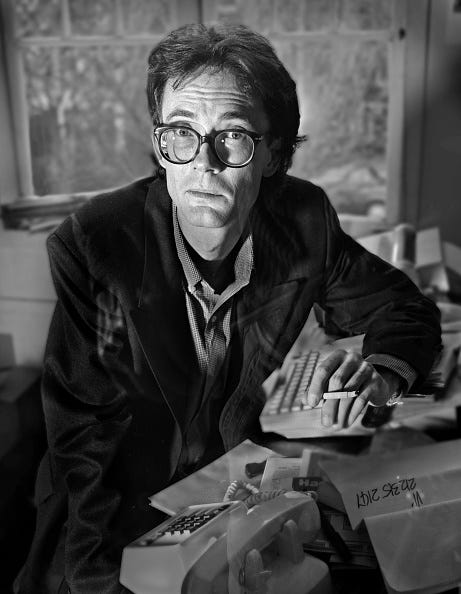Neuromancer: The Book That Wrote the Internet
Remembering William Gibson’s Future

While sitting in front of his Hermes 2000 typewriter back in the early 80s, William Gibson wrote a novel that predicted many of the technologies we are familiar with today, including the Internet, virtual reality and artificial intelligence, even though he had no experience using a computer himself.
Reading Neuromancer is like ingesting a hallucinatory drug—a drug that moves your mind in exhilarating, unexpected directions and has almost no negative side effects.
Someone reading a draft of this article asked me why reading Neuromancer is like being in a drug-induced haze. I could respond by pointing out that Case, one of the main characters, is almost constantly in a chemically induced state. As you follow his journey through the story, you will likely become a bit drugged vicariously. I could also mention the language that Gibson uses to describe his imaginary world, a language that Bruce Sterling1, a science fiction writer contemporary with Gibson, said was genuinely baffling to people who encountered it for the first time. But I don’t want to give the story away. You really need to ingest the drug yourself. Everyone who takes a hit of Neuromancer has a different trip.
The Birth of Neuromancer
William Gibson was enlisted to write a novel by the late Terry Carr, a science fiction anthologist. Carr had commissioned a limited series of first novels for Ace Books - his Ace SF Specials. He asked if Gibson would care to write one. Gibson agreed to complete a novel in a year and struggled to hand in a finished manuscript 18 months later.
When asked how he came up with the virtual world he describes in Neuromancer, Gibson mentions his experience with the first Sony Walkman, a device with an intimate interface that he could carry around. But it was watching kids playing in arcades that provided the inspiration Gibson needed to realize his vision.
And I thought, well, there’s a space behind the screen …Those spaces are all the same space. And as soon as I thought that …you know … I had it. William Gibson2
Gibson realized he needed to come up with a buzzword to describe the space behind the screen. He settled on cyberspace. A word he felt was evocative yet essentially meaningless.
In an interview with Paris Review, Gibson says he needs to begin every book by coming up with the first sentence. After coming up with an opening sentence, Gibson rarely changes it, even after a book is completed. He says he doesn’t have the entire novel “in his head” as other writers claim to do. He writes as though he is removing excess wood from a block to reveal the carving beneath.
It's like that joke about the violin maker who was asked how he made a violin and answered that he started with a piece of wood and removed everything that wasn't a violin. That's what I do when I'm writing a novel, except somehow I'm simultaneously generating the wood as I'm carving it. William Gibson
Gibson also makes it clear that writing for him is hard. The word that he most often uses to describe his emotional state while writing Neuromancer isn’t tired or stressed; it is terrified.
Gibson feels we live in an incomprehensible present, and writes to illuminate the moment. He claims he doesn’t have a conscious creative process at all. His books don’t happen because he thinks about them, they happen because he writes them—they emerge from the actual process of putting one word after another. He says that, if he is achieving something, “the characters become impossible to control.” Despite his best efforts he doesn’t have reliable access to his unconscious creative process. He makes a deal with himself “to turn up and make a real effort to see if there’s any incoming mail.”3 The writing process described by Gibson is like laboriously building a house brick by brick without any idea of how it will look until it is finished.
Neuromancer was released at the same time as the Apple Macintosh.
Reception
Far from being met with the “hostile or indifferent stares,” Gibson expected4. Neuromancer would eventually sell over six million copies. Neuromancer was the first novel to win the Nebula, the Hugo, and Philip K. Dick Awards for a paperback original, an unprecedented achievement described by the Mail & Guardian as "the sci-fi writer's version of winning the Goncourt, Booker, and Pulitzer prizes in the same year." The Nebula Awards Website says of Neuromancer, “It was as if someone turned on a light. The future blazed into existence with each deliberate word that William Gibson laid down.”
What Gibson Got Right
In Neuromancer, Gibson coined the word cyberspace and described the future of networked computers with uncanny accuracy. He also predicted artificial intelligence. He had never used a computer but had somehow managed to come up with a vision of what a network of computers might look like.5
Gibson wrote Neuromancer nearly forty years ago in a world with very few personal computers. People looked at each other’s faces rather than at their phones. The World Wide Web wouldn’t appear for almost a decade. Artificial Intelligence didn’t exist.
We were trying to be more intelligent all by ourselves.
Imagine sitting in front of a typewriter back then and trying to come up with a vision of how we live now. For most people, it would be an impossible task.
William Gibson did it rather well.
Epilogue
Is there a way of experiencing the sort of vertigo induced by reading Neuromancer back in 1984 forty years later in the present? I used NotebookLM, an AI developed by Google Labs, to process this text (the text you are reading now) to create a podcast. The result might be illuminating.
The podcast isn’t two people talking, it is an AI digesting the text and video it is fed, combining it with material it finds searching the Internet, and then creating two human-sounding voices in order to express its findings. It isn’t perfect, but it is surprisingly powerful, and evolving much faster than a biological organism. If listening to this podcast is unsettling, remember that William Gibson predicted artificial intelligence forty years ago. To try it yourself go to the Website NotebookLM.
NotebookLM-Neuromancer Podcast (10.29)
Additional Material
Article in The Guardian: William Gibson: how I wrote Neuromancer
Wikipedia entry for Neuromancer.
Article in The Creative Mind: William Gibson on a Writer’s Inner Life
Interview in The Paris Review: William Gibson, The Art of Fiction No. 211
Nebula Awards Website entry: Neuromancer
YouTube video 1:27:37 William Gibson Interview "No Maps for These Territories"
An episode of Science Fiction with Damien Walter YouTube video 9:13 Denis Villeneuve's Neuromancer
YouTube video 9:02 Adam Savage's Top 5 Science Fiction Books (Neuromancer is #1)
Footnotes
Bruce Sterling being interviewed in No Maps for These Territories. The interview begins at roughly 23:35.
Gibson talks about coming up with his idea of cyberspace in No Maps for These Territories at roughly 55:25.
Gibson talks about his writing process in No Maps for These Territories from 1:06:35
In the Guardian article, it is clear that Gibson had an enormous problem with self-doubt and imposter syndrome.
The passage often quoted as a description of cyberspace:
"Cyberspace. A consensual hallucination experienced daily by billions of legitimate operators,in every nation, by children being taught mathematical concepts... A graphic representation of data abstracted from the banks of every computer in the human system. Unthinkable complexity. Lines of light ranged in the nonspace of the mind, clusters and constellations of data. Like city lights, receding..." William Gibson Neuromancer Page 51

